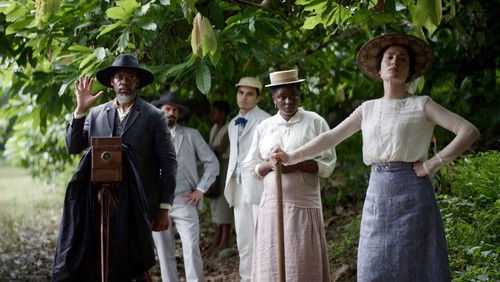Flucht von der Teufelsinsel (1946)
15KFlucht von der Teufelsinsel: Directed by Henry Levin. With Louis Hayward, Barbara Britton, George Macready, Una O’Connor. Edmond Dantes is falsely accused of a crime and imprisoned. After 14 years ,He escapes and gets great wealth under the help of the Abbé Faria. Revitalised as the name of Monte Cristo,is to destroy the designs of corrupt and evil men.
“To begin with, I watched this on the occasion of star Louis Haywardu0026#39;s birthday: being one of the most prolific swashbuckling stars during the genreu0026#39;s Hollywood heyday, I will be including four of his efforts in all during the current Easter marathon. The others are FORTUNES OF CAPTAIN BLOOD (1950) and its sequel, CAPTAIN PIRATE (1952), and the Dick Turpin adventure THE LADY AND THE BANDIT (1951); however, the last remaining of his vehicles in this vein and which – like the movie under review – was inspired by the writings of Alexandre Dumas, i.e. LADY IN THE IRON MASK (1952), seems hard to come by at the moment! With this in mind, THE RETURN OF MONTE CRISTO itself is here accompanied by burnt-in Spanish subtitles!u003cbr/u003eu003cbr/u003eIn any case, this is Haywardu0026#39;s own second stab at playing the progeny of u0026quot;The Count Of Monte Cristou0026quot; – the first time in 1940u0026#39;s SON OF MONTE CRISTO (1940); for what it is worth, while ostensibly a sequel, this one is more of an updated reworking of the original! Indeed, as if things were not already clear enough, the protagonist is called Edmond Dantes! Anyway, Hayward plays a physician here who, upon turning 21, is told by his famous ancestoru0026#39;s lawyer Henry Stephenson to be the sole heir of the vast Monte Cristo fortune; however, at the reading of the will, this is contended by another relative (Barbara Britton) and her various eminent patrons (the presiding judge Ludwig Donath – named Jean Lafitte{!}, bank manager and the girlu0026#39;s guardian Ray Collins and Police Chief and Brittonu0026#39;s unloved fiancé George Macready). Needless to say, this complication gives rise to a virtual retread of the treachery, incarceration, escape and revenge plot we are all familiar with. That said, the time discrepancy introduces some interesting novelties: instead of the Château du0026#39;If, Dantes is taken to Devilu0026#39;s Island (presided over by inevitably brutish overseer Ivan Triesault); the Abbeu0026#39; Faria figure (here celebrated stage performer and political prisoner Steven Geray) does not die but makes it back with the protagonist and assists him in his elaborate retribution; similarly, rather than being thought dead, Hayward and Geray are believed to be bubonic plague-carriers thanks to the formeru0026#39;s botanical/medical expertise!u003cbr/u003eu003cbr/u003eOnce back in Paris, he makes full use of his companionu0026#39;s artistic baggage: not only using his theatre to hide in but he adopts several disguises (most amusingly as a hunchbacked but tenacious Jewish detective named u0026quot;Redbeardu0026quot;{!}, a bank auditor and – preposterously – Emperor Napoleon III!) to right the wrong done him. In a nice twist, the faint-hearted judge dies – ostensibly infected by the u0026#39;diseaseu0026#39; Hayward gave himself – in the old Château du0026#39;If; Collinsu0026#39; come-uppance occurs when Geray casually mentions that he is bankrupt in a crowded town square – so that his clients flood to withdraw their savings while violently turning on him (conveniently while Dantes is checking the books); Macreadyu0026#39;s, too, is the stuff of melodrama – a full confession in what appears to be the deserted theatre stage, only for the lights to go up soon after revealing an audience of irate private citizens, to whom the villain is passed so as to receive his just desserts as if he were Dr. Moreau or some such human monster! Of course, the initial misunderstanding between the male and female leads (not helped by an underused Una Ou0026#39;Connoru0026#39;s declamations as Brittonu0026#39;s grumpy maid) is well smoothed over by the end…so that Britton does not even have to relinquish her title of u0026quot;The Countess Of Monte Cristou0026quot; (for the record, three films were made bearing the latter title alone, but none seem to have much at all to do with Dantes or Dumas!).u003cbr/u003eu003cbr/u003eDespite the far-fetched narrative embellishments described above, the film is a most enjoyable and good-looking costumer (since there is no swordplay involved, I have refrained from calling it a swashbuckler), unassumingly yet zestfully handled by all concerned (most of whom are quite practiced at this sort of thing). Incidentally, I have a number of other Monte Cristo-related stuff to go through – including at least three direct adaptations of the source material (dating from 1922 {U.S.}, 1929 {France} and 1966 {Italian TV mini-series}) and as many variations, namely MASK OF THE AVENGER and THE SWORD OF MONTE CRISTO (both 1951) and THE TREASURE OF MONTE CRISTO (1961; also known as THE SECRET OF MONTE CRISTO, since there was already a 1949 noir by the filmu0026#39;s original moniker!).”









